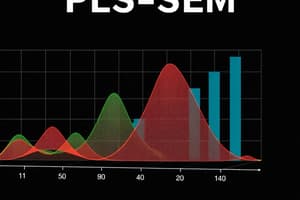Podcast
Questions and Answers
What is the main purpose of path analysis in Structural Equation Modeling (SEM)?
What is the main purpose of path analysis in Structural Equation Modeling (SEM)?
- To develop a theoretical model
- To identify latent variables
- To measure the goodness of fit
- To estimate path coefficients among observed variables (correct)
What do latent variables represent in SEM?
What do latent variables represent in SEM?
- Variables that have a linear relationship
- Variables that are directly measured
- Variables that are not important in the model
- Variables that are theoretical and unobserved (correct)
What does the stage of 'Measuring constructs' involve in Model Development?
What does the stage of 'Measuring constructs' involve in Model Development?
- Creating a theoretical model
- Selecting appropriate measures for the constructs (correct)
- Testing the goodness of fit
- Identifying latent variables
Why is it important to test competing models in Structural Equation Modeling (SEM)?
Why is it important to test competing models in Structural Equation Modeling (SEM)?
What is the purpose of checking a model's assumptions?
What is the purpose of checking a model's assumptions?
In structural equation modeling, what does 'identification' refer to?
In structural equation modeling, what does 'identification' refer to?
Which estimation technique is commonly used in structural equation modeling?
Which estimation technique is commonly used in structural equation modeling?
What do goodness-of-fit indices measure in structural equation modeling?
What do goodness-of-fit indices measure in structural equation modeling?
What is one reason why issues of identification can arise in a model?
What is one reason why issues of identification can arise in a model?
How are alternative models typically compared in structural equation modeling?
How are alternative models typically compared in structural equation modeling?
What is the primary focus of measurement models in Structural Equation Modeling (SEM)?
What is the primary focus of measurement models in Structural Equation Modeling (SEM)?
In SEM, what do observed variables represent?
In SEM, what do observed variables represent?
What is the primary purpose of structure models in Structural Equation Modeling (SEM)?
What is the primary purpose of structure models in Structural Equation Modeling (SEM)?
Why is confirmatory factor analysis (CFA) typically used in SEM?
Why is confirmatory factor analysis (CFA) typically used in SEM?
What is the main purpose of 'Model specification' in the Six Stages of Model Development?
What is the main purpose of 'Model specification' in the Six Stages of Model Development?
In Structural Equation Modeling (SEM), what is the role of 'Measurement model specification' in the model development process?
In Structural Equation Modeling (SEM), what is the role of 'Measurement model specification' in the model development process?
Why is 'Data collection' a critical stage in Model Development for testing structural models?
Why is 'Data collection' a critical stage in Model Development for testing structural models?
What is the purpose of 'Estimation' in Structural Equation Modeling?
What is the purpose of 'Estimation' in Structural Equation Modeling?
'Identification' in SEM refers to:
'Identification' in SEM refers to:
'Goodness-of-Fit' indices are used to:
'Goodness-of-Fit' indices are used to:
Flashcards are hidden until you start studying
Study Notes
Basics of Structural Equation Modeling (SEM)
Structural Equation Modeling (SEM) is a powerful, multivariate statistical technique that has gained popularity in various fields of research, particularly in social and behavioral sciences. SEM enables researchers to analyze complex relationships among observed and latent variables, allowing them to test hypothesized models and understand underlying mechanisms.
Subtopics of SEM
- Path analysis: Investigates the relationships among observed variables using regression and correlations to estimate path coefficients.
- Measurement and structure models: Identify the underlying constructs and relationships among observed variables.
- Variables and constructs: Latent (construct) variables are unobserved, theoretical constructs that underlie multiple observed variables.
Modeling Strategies
- Conceptualization: Developing a theoretical model that represents the relationships among the variables, constructs, and latent variables.
- Testing the model: Assessing the goodness of fit and competing models to validate the proposed theoretical model.
Six Stages in Model Development
- Formulating a theory: Developing a theoretical model that specifies the constructs, relationships, and pathways.
- Measuring constructs: Selecting appropriate measures for the constructs.
- Estimating the model: Fitting the model to the data using estimation techniques such as Maximum Likelihood, Weighted Least Squares, or Bayesian estimation.
- Checking the model's assumptions: Assessing the validity of the assumptions made in the model, such as normality, linearity, and homoscedasticity.
- Testing the model's goodness of fit: Measuring the model's fit using various indices like the Goodness of Fit Index (GFI), Root Mean Square Error of Approximation (RMSEA), and Comparative Fit Index (CFI).
- Comparing models: Analyzing alternative models using goodness-of-fit indices and statistical tests, such as chi-square difference tests and Akaike Information Criterion.
Model Structure
The structural model represents the relationships among latent variables, while the measurement model specifies the relationships between observed variables and their corresponding latent constructs.
Different Estimation Techniques
The most commonly used estimation techniques are Maximum Likelihood (ML), Weighted Least Squares (WLS), and Bayesian estimation. Each method has its own advantages and assumptions, so researchers must choose the appropriate estimation technique based on their research design and data structure.
Issues of Identification
Identification refers to the ability to estimate the model parameters uniquely. A model is identified if there is a one-to-one mapping between the model parameters and the observable data. Issues of identification can arise due to collinearity, unidentified model parameters, or model constraints.
Goodness of Fits
Goodness-of-fit indices are used to measure how well the proposed model fits the observed data. Popular indices include the Goodness of Fit Index (GFI), Root Mean Square Error of Approximation (RMSEA), and Comparative Fit Index (CFI).
Structural Models GoFs
Goodness-of-fit indices are applied to structural models to measure their fit to the data.
Competitive Fit
Comparing alternative models using statistical tests and fit indices to determine the best-fitting model.
In summary, structural equation modeling is a powerful and flexible tool for analyzing complex relationships among observed and latent variables. By applying SEM, researchers can test hypothesized models, identify underlying constructs, and determine the strength of relationships among variables. With proper conceptualization, model development, and statistical analysis, SEM enables researchers to gain a deeper understanding of the complex dynamics that underlie various phenomena.
Studying That Suits You
Use AI to generate personalized quizzes and flashcards to suit your learning preferences.




